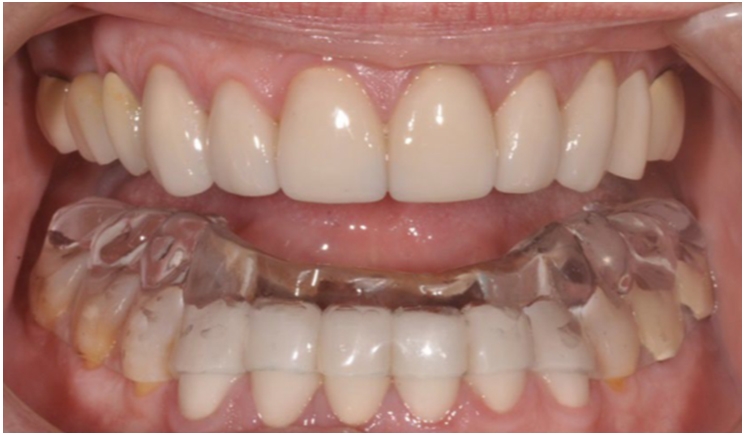
Recent research has brought attention to the potentially harmful effects of traditional nightguards on the airway by increasing snoring, apnea, and hypopnea. Airway First treatment planning necessitated the creation of the Airway Centric Guided (ACG) Day/Night Appliance System, which maintains an open airway during sleep and parafunction as well as during daytime activities when needed.
Background
Dentists historically have needed to prescribe nightguards for about 40% of patients to prevent tooth wear and to protect restorations, laminates, and crowns from the forces of parafunction. Nightguards also have been fabricated for patients complaining of jaw pain on awakening or during sleep.
There has not been much progress in nightguards for the past 50 years. The Lucia jig has morphed into the Pankey Bite Stop. The Kois deprogrammer is recommended for short-term wear. And, the nociceptive trigeminal inhibitor or NTI was introduced for tension suppression.
Most nightguards comprise a flat plane with cuspid and anterior guidance for immediate posterior disclusion. Some bites were taken in centric relation with the patient lying supine or, in some cases, upright. Other appliances were made in centric occlusion (CO) or maximum intercuspation (MIP). Many dentists have never considered the use of an appliance during the day, much less one that opens up the airway.
Patient complaints often include jaw clicking, jaw locking, jaw pain, headache, and fatigue or non-refreshing sleep. The following two cases illustrate powerful transformations and explain how daytime and nighttime appliance therapy complement both the temporomandibular joint (TMJ) and the airway to alleviate these symptoms.
Case 1
Our first patient presented with the chief complaints of bilateral clicking, clenching and grinding, and snoring (Figure 1). On clinical examination, there was exquisite left-sided masticatory and cervical muscle pain on palpation. The left TMJ had severe pain, compression, and adverse loading with painful closing and opening clicks. The interocclusal opening was 42 mm.
On dental examination, there were multiple abfraction lesions in all four quadrants and a narrow maxillary arch (Figure 2). There also was a loss of lower third face height (Figure 3). CBCT imaging revealed arthritic changes in the right and left mandibular condyles as well as decreased joint space bilaterally (Figure 4). The diagnosis was myofascial pain.
We treated the patient with an ACG Day lower repositioning appliance to decompress both TMJs and allow healing to occur (Figure 5). The appliance increases joint space and serves as a biofeedback device to remind the patient to keep her lips together and her teeth apart with her tongue against the rugae of the palate. It also increases the length of the masseter and temporal muscles while alleviating clenching.
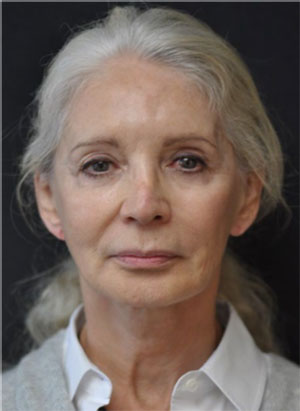 |
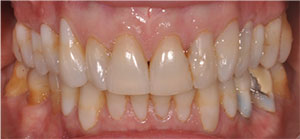 |
| Figure 1. Our first patient presented with bilateral clicking, clenching and grinding, and snoring. | Figure 2. There were multiple abfraction lesions in all four quadrants and a narrow maxillary arch. |
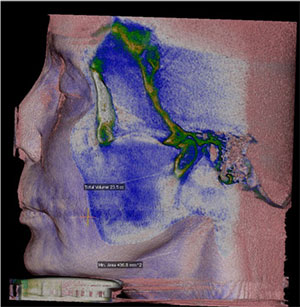 |
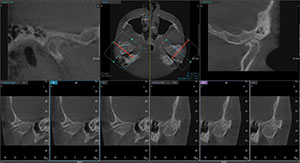 |
| Figure 3. The patient presented with a loss of lower third of face height. | Figure 4. CBCT imaging revealed arthritic changes in the right and left mandibular condyles as well as decreased joint space in the left TMJ. |
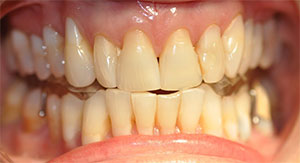 |
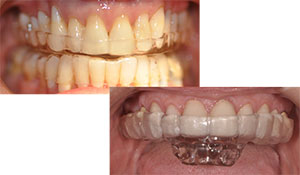 |
| Figure 5. A lower repositioning appliance was prescribed for the day to decompress both TMJs and allow healing to occur. | Figure 6. An upper antiretrusion appliance with a ramp and lower stabilizer for height was prescribed for nighttime use. |
An upper anti-retrusion appliance was prescribed to be worn at night to maintain the structural integrity of the TMJ during sleep and parafunction as well as to resist the effects of gravity and maintain an open airway, which will allow the patient to wake up with no pain and no clicking, feeling refreshed.
The treatment alleviated the clicking and snoring and produced an incredible facial transformation. The patient will require a third round of orthodontic treatment and possible restorative treatment.
Case 2
Our second patient presented with headache, neck pain, and facial pain (Figure 8). She was referred to us by an ENT/facial plastic surgeon who had recently completed a revision rhinoplasty. Her dentist had discovered jaw clicking and TMJ pain.
The clinical exam revealed bilateral masseter tenderness, as well as temporal tendon inflammation. There were bilateral late closing clicks. CBCT imaging showed a loss of lower third face height (Figure 9) and loss of joint space bilaterally in the right and left TMJ (Figure 10).
The diagnosis was disk displacement with reduction bilaterally as well as myofascial pain.
We prescribed an ACG Functional appliance to wear during the day to alleviate the clicking in the right and left TMJs and manage the effects of parafunction (Figure 11). The lower full coverage anatomic splint restores face height, improves aesthetics, alleviates clicking and pain, and improves heart rate variability.
An ACG Night antiretrusion appliance was prescribed to alleviate the clicking in the right and left TMJs as well as to manage the effects of parafunction (Figure 12). This appliance also maintains an open airway during sleep, allowing the patient to awaken refreshed.
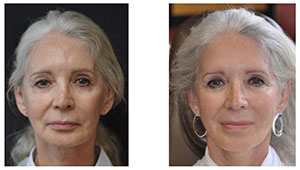 |
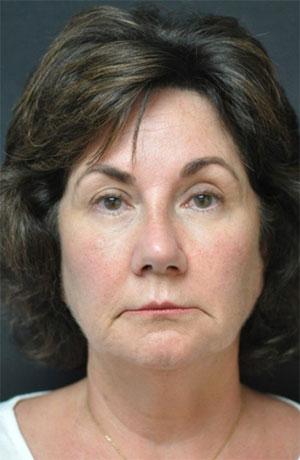 |
| Figure 7. The before (left) and after (right) photos illustrate the facial transformation that came with better sleep, less inflammation, and restored lower third face height. | Figure 8. Our second patient presented with headache, neck pain, and facial pain. |
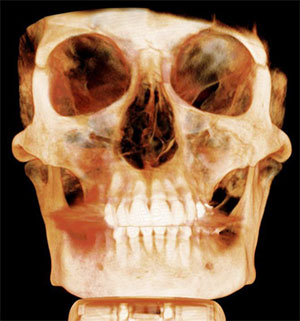 |
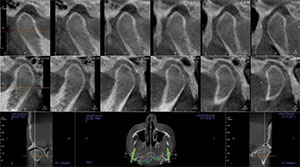 |
| Figure 9. CBCT imaging revealed a loss of lower third face height. | Figure 10. CBCT imaging also revealed a loss of bilateral joint space in the right and left TMJ. |
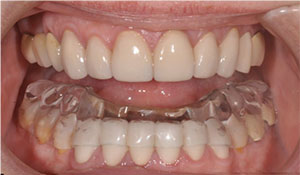 |
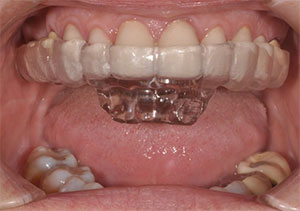 |
| Figure 11. An ACG functional appliance was prescribed for daytime use to alleviate the clicking in the right and left TMJs and to manage the effects of parafunction. | Figure 12. The ACG night antiretrusion appliance alleviates the clicking in the TMJs, manages the effects of paratrusion, and maintains an open airway during sleep. |
The treatment alleviated the headache and neck and facial pain. It also produced an incredible facial transformation, illustrating the scope of treatment and what is possible with the ACG system using both day and night therapy (Figure 13). Note how the eyes are open, bright, and white. The facial shape also is improved with the restoration of the lower third face height.
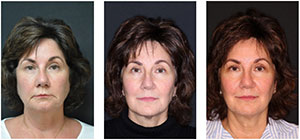 |
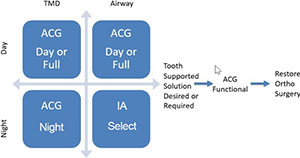 |
| Figure 13. Photos taken before treatment (left), with the ACG functional appliance (middle), and with the ACG functional appliance and fillers (reveal) an incredible facial transformation. | Figure 14. The ACG grid helps clinicians select the best appliance for TMDs and airway disorders. |
The ACG Grid
The ACG grid helps the dentist select the best appliance for temporomandibular disorders (TMDs) and airway disorders, day and night (Figure 14). TMD is treated during the day with either a segmented or a full lower appliance, ACG Day and ACG Full. TMD at night is best managed with ACG Night, which also is the best choice for a nightguard for clenching to avoid closing the airway. Once diagnosed with a breathing-related or airway-related sleep disorder due to a collapsible airway, consider a ProSomnus IA or select devices that allow titratability.
Conclusion
As we better understand the importance of protecting the airway, the need for this novel day/night appliance system becomes clear. Dentists should be aware that they may be opening or closing the airway when they use a conventional nightguard. Also, CBCT imaging is a great tool for visualizing the size of the airway and choosing the best appliance for the patient. Knowledge of the anatomy and physiology of the collapsible airway is extremely important in uniquely susceptible modern homo sapiens.
We have seen remarkable transformations in thousands of similar cases with reduced pain and improved function. The aesthetic results speak for themselves with improved lower third face height, open and bright eyes, and glowing skin tone. Deeper restorative sleep with improved oxygenation is one explanation.
Dr. Gelb is the director of the Gelb Center, which has offices in White Plains and New York, New York. He received his DDS from the Columbia University College of Dental Medicine and his MS from SUNY at Buffalo School of Dental Medicine. He is the coauthor of GASP: Airway Health—The Hidden Path to Wellness and the cofounder of both the Foundation for Airway Health and the American Academy of Physiological Medicine and Dentistry. He also is the inventor of the ACG Airway Centric System with the help of ProSomnus Sleep Technologies, where he is a consultant. He can be reached at mgelb@gelbcenter.com.
Dr. Dume is the clinical director of the Gelb Center in New York City, where he has been working for the past four years. He finished his dental training at Rome Tor Vergata in Tirana, Albania, and came to the United States in 2011. He also is the co-inventor of the Juvabite sleep appliance and the Select IA appliance, which are part of the ACG Airway Centric System by ProSomnus Sleep Technologies, where he is a consultant. He can be reached at edume@gelbcenter.com.
Dr. Murphy is the lead faculty for clinical education at ProSomnus Sleep Technologies. He also is the principal of Funktional Consulting, serves on the guest faculty at the University of Detroit School of Dentistry, and is a regular presenter on business development, practice management, and leadership at the Pankey Institute. He also has served on the boards of directors of the Pankey Institute, the National Association of Dental Laboratories, the Identalloy Council, the Foundation for Dental Laboratory Technology, St. Vincent DePaul’s Dental Center, and the Dental Advisor. He lectures internationally on leadership, practice management, communication, case acceptance, planning, occlusion, sleep, and TMD. He can be reached at mtmurphydds@gmail.com.
Related Articles
Orthodontic Dentistry: The Next Frontier
ALF Presents a New Solution for an Old Problem—Malocclusion
How You Can Stop the Epidemic of Smaller Jaws











